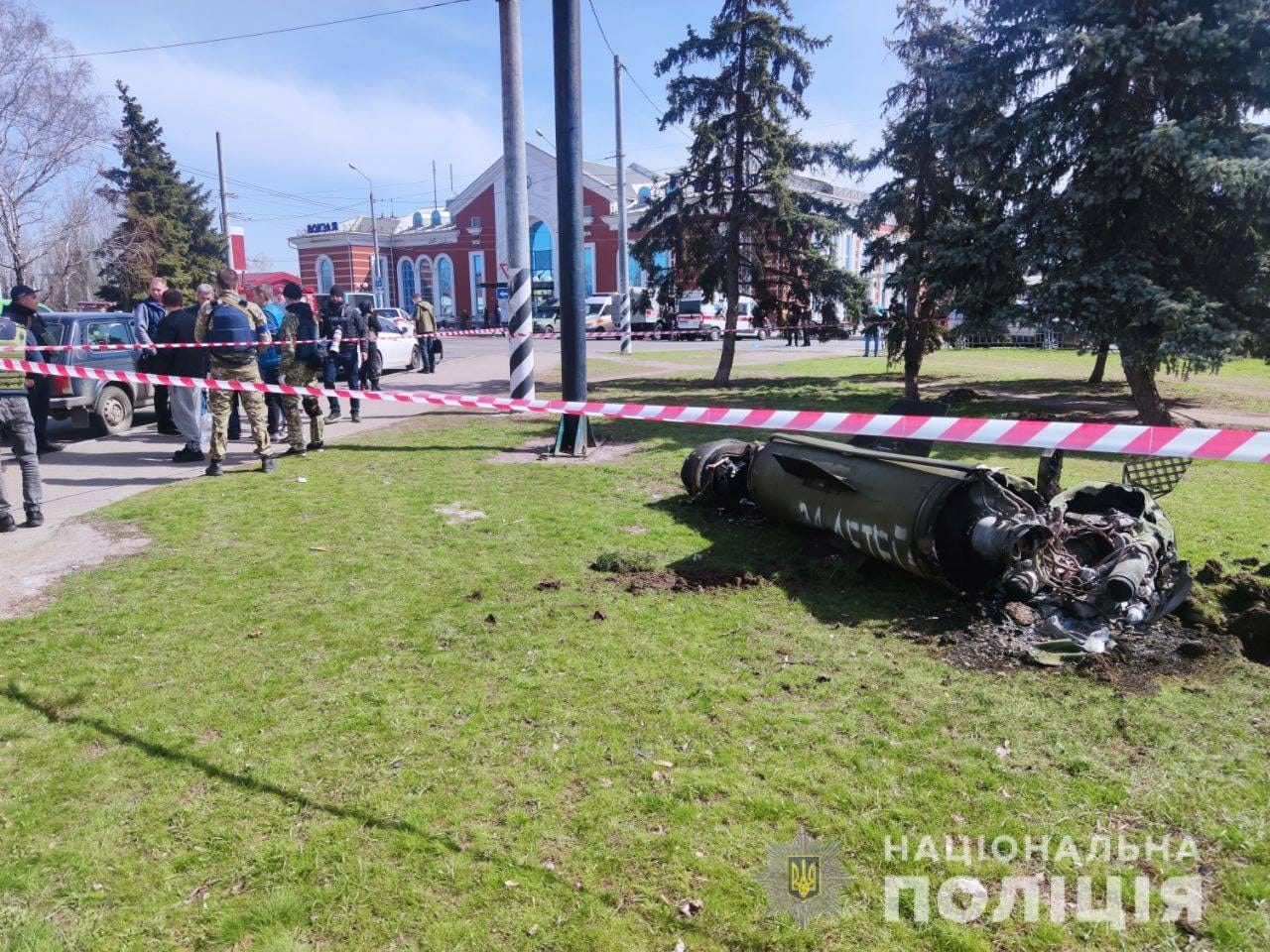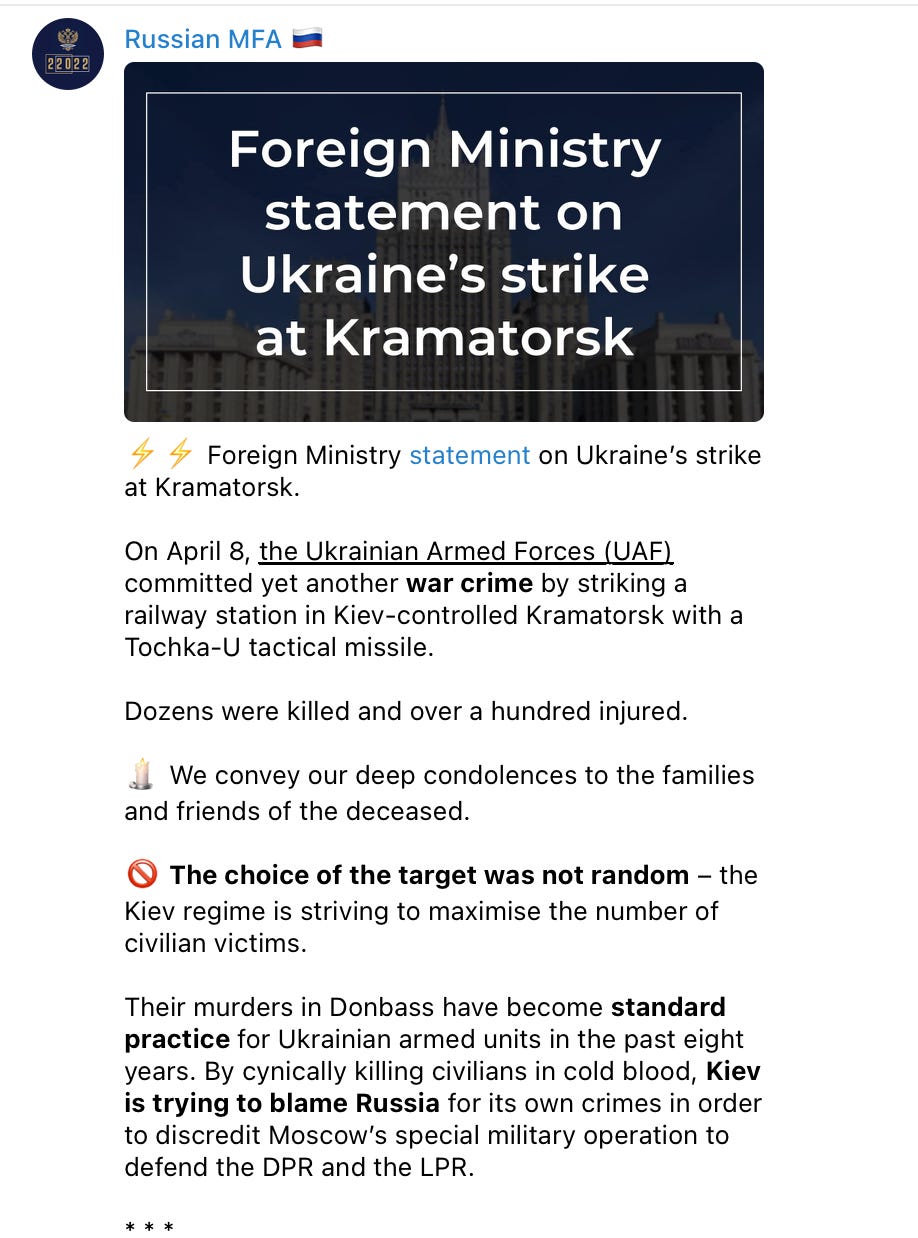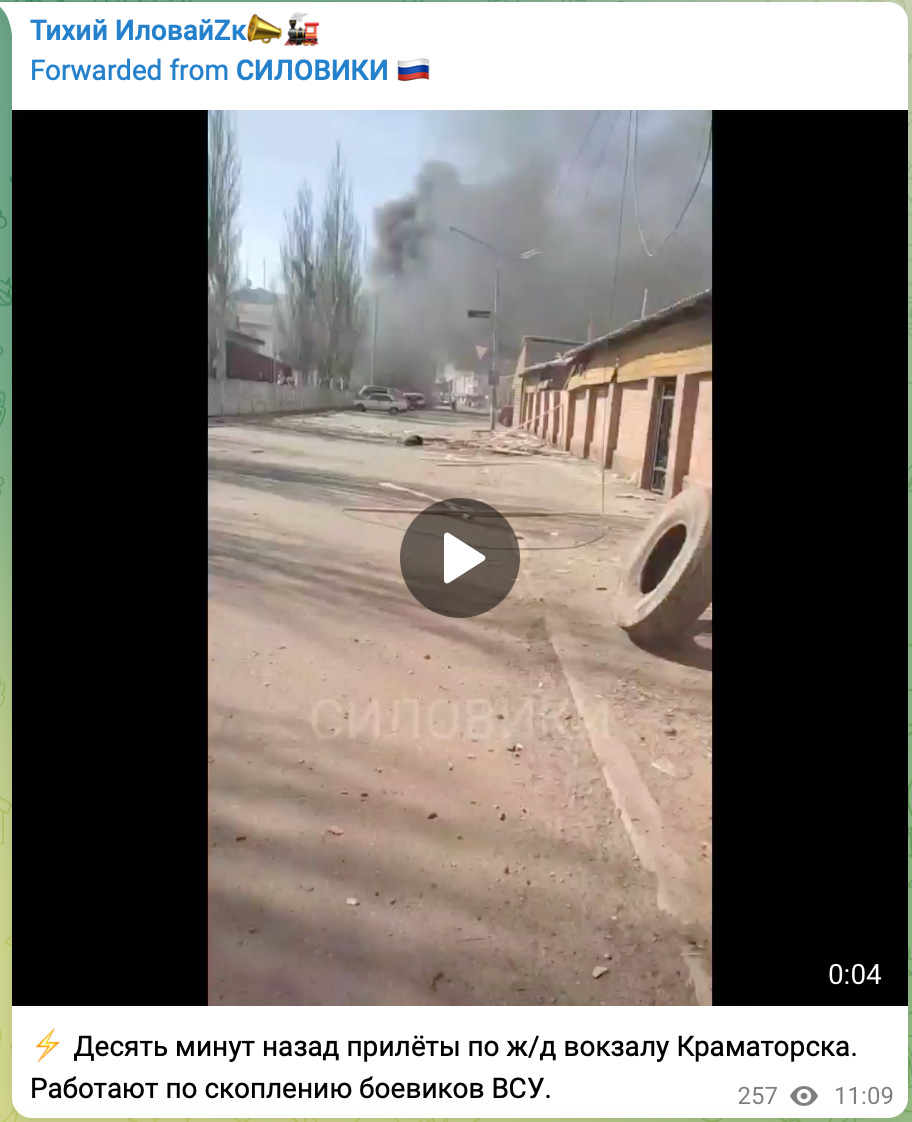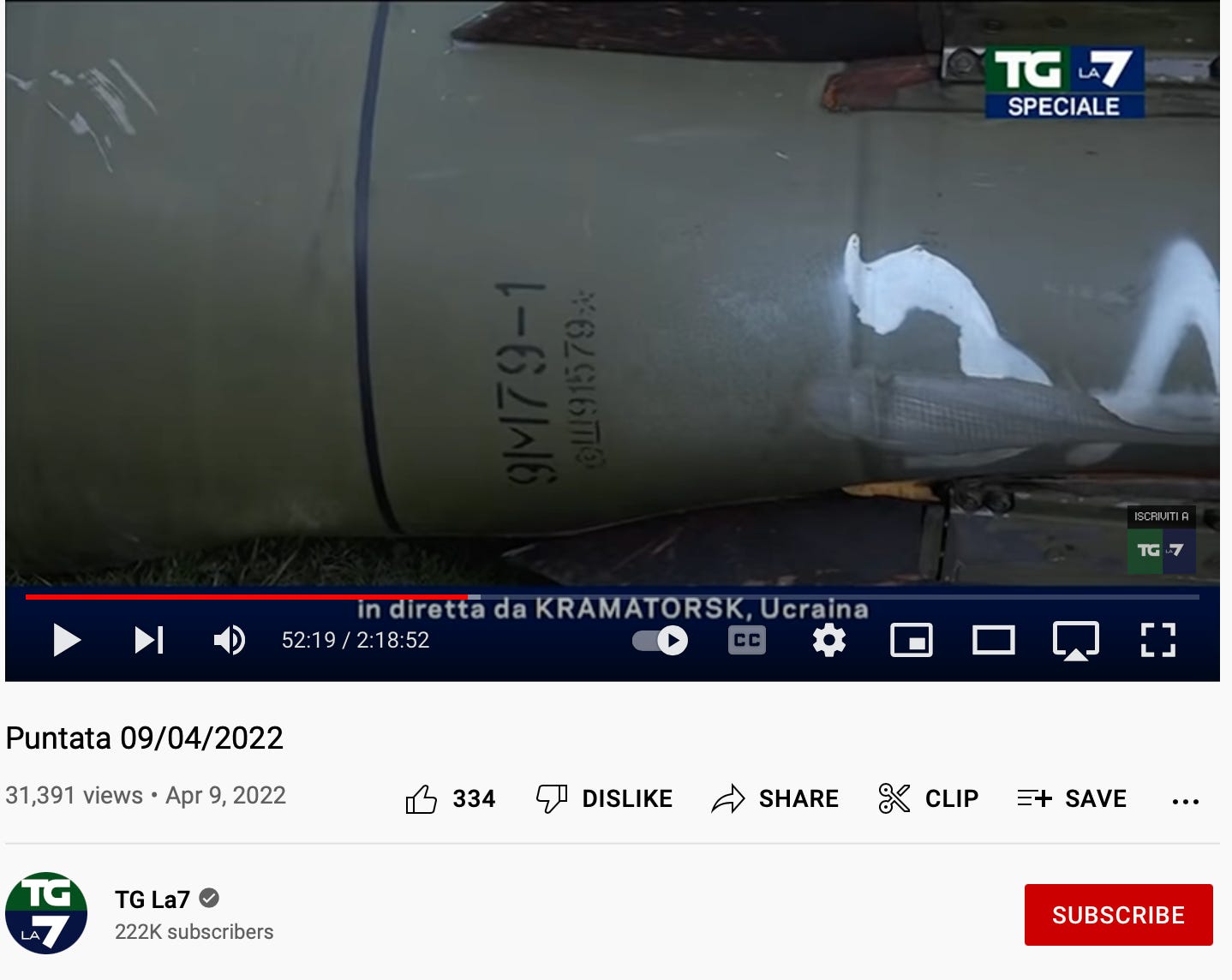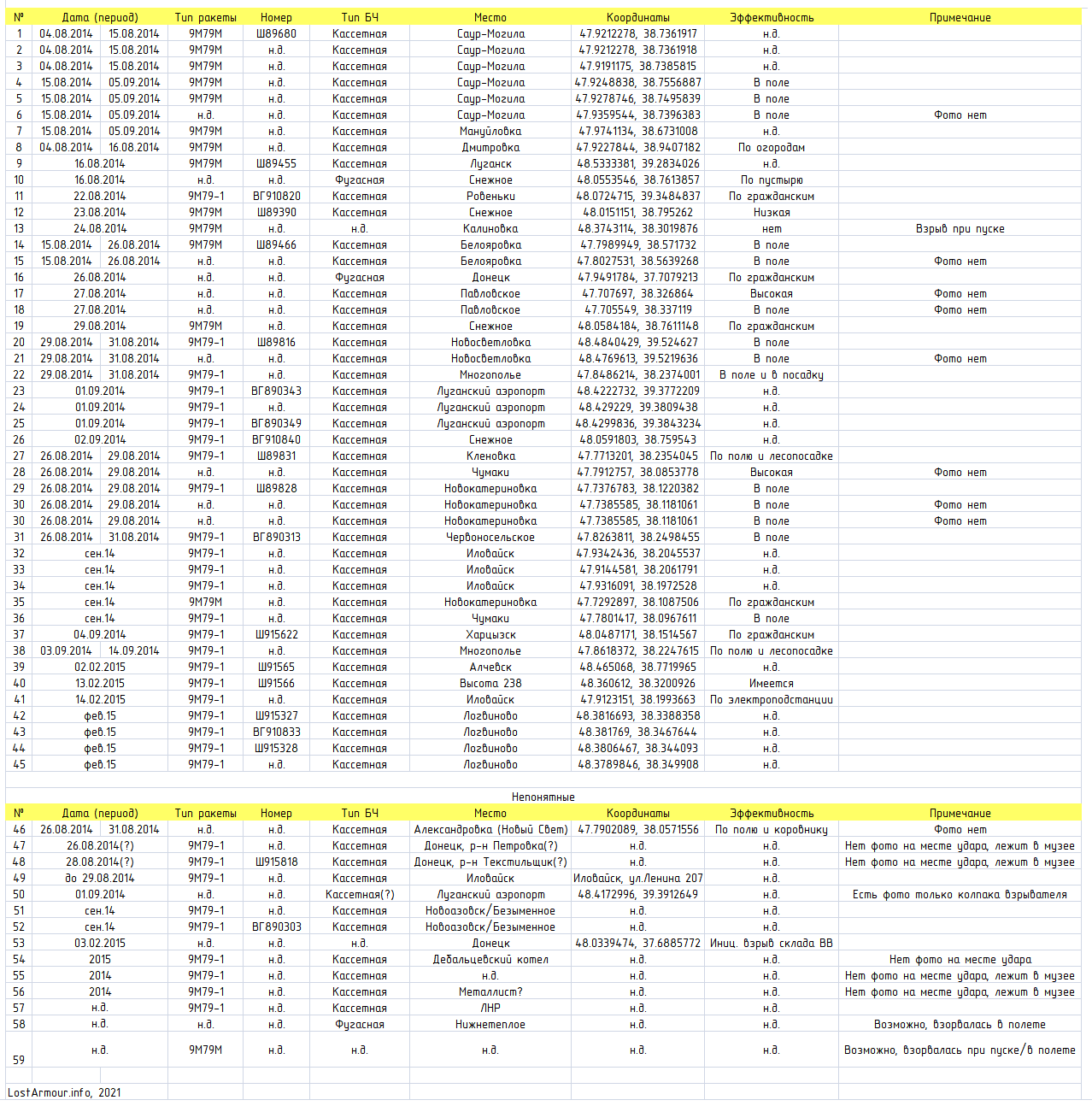Ukraine Crisis: Why Kramatorsk has not become another Bucha
A detailed analysis of a deadly strike and the information fog around it
On the morning of April, 7, the Tochka-U missile hit a train station in the Ukrainian town of Kramatorsk killing 57 people, including 5 children, and wounding 114, according to local authorities. Yet another horrifying attack on civilians in the nearly two-month long Russia-Ukraine standoff, it was quickly blamed on Russia by Ukraine as well as the global community.
Photo Credit: Wikimedia Commons
Russia refuted the allegations, same as it had earlier done in the case of Bucha — after the shocking videos from this town near Kiyv (Google’s autocorrect insists I should use Kiev, but I am afraid global readers will label me as Russian propaganda, find here why) appeared in the Ukrainian and global media on April 1.
In the case of the Kramatorsk, the global outrage didn’t last long. Despite (or because) unlike in the case of Bucha, where there isn’t much demonstrative evidence of crimes allegedly done by the Russian army available (there are few satellite images and videos, to be sure, but they do not prove deliberate killings of over 300 civilians), in case of Kramatorks there was an exact weapon, and the direction in which it flew.
Spoiler:
While debates over Kramatorks have nearly died out after the Russian officials and the media have successfully pushed the claim that the serial number of the missile proves that this missile belonged to Ukrainian armed forces, there is no undeniable proof (yet). The only such proof would be in the form of an archived shipment document from the Votkinsk plant where such missiles were manufactured in the 1980s and then supplied to the army units all over the Soviet Union — from Kiyv to Vladivostok. We talk about this in detail a bit later.
Facts
Kramatorsk is a town in Ukraine, just a few kilometers from the front line, that has been under heavy shelling over the past week, prompting authorities to recommend people to leave with no delay. Evacuation information was shared by Ukrainian railways on April 7, which is why the train station was full of people (over 4,000 as per Ukrainian authorities) when the missile hit.
The strike was reported at around 10:30 am (Kyiv and Moscow time). Alexander Kamyshin, the head of the Ukrainian Railways (Ukrzaliznytsia JSC), reported the attack at 10:44 am in his Telegram channel. Some 30 minutes later the head of the Donetsk regional state military administration Pavlo Kyrylenko, announced on Facebook the train station had been attacked by a Russian Iskander short-range ballistic missile. The original post was edited later to state it was a Tochka-U.
Several other Ukrainian officials, including president Zleensky advisor Alexey Arestovich, claimed it was Iskander missiles (Arestovich statements on Facebook and Telegram were not edited and still carry Iskander missile in them) despite Ukraine’s defense ministry later in the day confirmed in its Facebook post it was the Tochka-U.
Russia reacted to the incident at 12:43 pm, refuting Kyiv’s claims that it was responsible for the attack and calling them (yet again) — a provocation. "We would like to emphasize that the Tochka-U tactical missiles, the fragments of which were found near the Kramatorsk railway station and published by eyewitnesses, are used only by the Ukrainian armed forces," the Russian defense Ministry stated.
Russia’s Ministry of Foreign Affairs reminded that on March 14, 2022 another Tochka-U missile has hit the center of Donetsk city killing 17 people and wounding another 36. “In both cases, the choice of the target was not random – the Kiev regime is striving to maximize the number of civilian victims. Their murders in Donbass have become standard practice for Ukrainian armed units in the past eight years,” the MFA statement said.
To be sure, March 14 attack on Donetsk (the largest city in the breakaway Donetsk People's Republic) was hardly reported by the international media (Google “Donetsk center Tochka-U” and you will see English-language coverage only by the Russian and Indian media in the first two pages of Google). This is despite many journalists (representing Russian media outlets as well as freelancers, including English-speaking journalists) were present at the scene and published footage no less horrifying than those from Kramatorsk or Bucha. Russia claimed Ukraine is responsible for the Donetsk attack. Ukraine denied the allegation and blamed it on the “separatists”.
Another important fact to note is that during the morning briefing on April 8, a few hours before the Kramatorks strike, the Ministry of Defense said it had hit Slavyansk, which is located 17 kilometers from Kramatorsk.
“High—precision air-launched missiles in the Donetsk region at the railway stations Pokrovsk, Slavyansk, Barvenkovo destroyed weapons and military equipment of the reserves of Ukrainian troops who arrived in Donbass”, - the spokesperson said. Semyon Pegov, a head of the WarGonzo project, has posted information about shelling in Slavyansk, calling it a “missile barrier”. “Russian troops did not allow railway trains with equipment to pass to Slavyansk and Kramatorsk,” he said.
“За детей” [That’s for the children] was scrubbed on the missile with white color paint, in Russian language. Both Ukraine and Russia have been constantly pointing out that children continue to be the victims of the conflict.
As on April 11 (in the 47 days of the war), 148 children died and 233 were wounded, according to UNHRW. The real figure could be much bigger. The war has affected 4.8 million of the country’s 7.5 million children, according to UNICEF, and nearly two-thirds of all Ukraine children have been displaced.

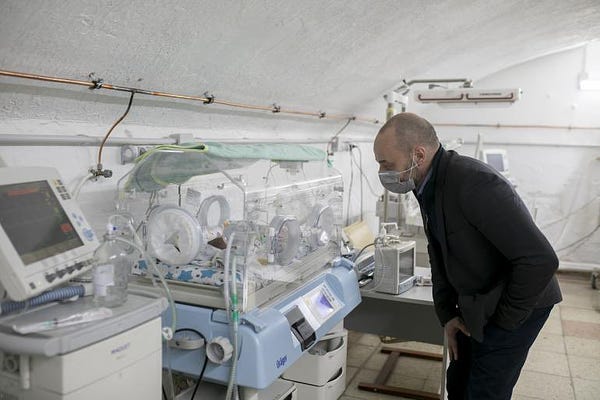
It was not clear though whether these figures include those children in Donetsk and Lugansk republics as well as territories that are at the moment under the control of the armed forces of Donetsk People's Republic (DNR) and the Luhansk People's Republic (LNR) and Russia. DNR officials claim 74 children were wounded in the 52 days of the escalation (DNR and LNR officials count the number of days starting from February 24 but from February 17 when, Ukraine violated the ceasefire with heavy shelling of various areas.
In March, international media published pictures of an installation from Lviv of 109 empty strollers symbolizing children killed in the ongoing fighting.
The pictures of an “Alley of Angels” in Donetsk, dedicated to 91 children who died from the shells of the Ukrainian army during the first active phase in 2014 (the memorial was opened in May 2015), are continuously shared by Russian media outlets and officials. Many of these accounts, however, are constantly getting blocked, fully or partially, by YouTube, Facebook and Twitter.



Both Ukraine and Russia had reasons to take “revenge” for the children killed by the 8-year long conflict. The fact that the writing on the missile was in Russian language (and not Ukrainian) is not relevant: data from the Institute of sociology of the National Academy of Sciences of Ukraine shows in 2020, 27.6% of the Ukrainian population routinely spoke Russian, and 21.3% used both languages.
The context
The reason it was easy to blame the deadly attack in Kramatorsk on Russia in the very first minutes were several Telegram posts and videos, the origin of which is questionable.
Few moments before the first announcement of the attack was published, multiple pro-Russia Telegram channels posted a video (originally shared by an anonymous “Siloviki” channel) of smoke coming from an area that is likely to be Kramatorks train station. The message said: “Ten minutes ago, an “incoming” hit Kramatorsk railway station. [Russian forces] Destroying a crowd of Ukrainian militants”).
This footage was immediately used as proof that Russian forces hit the train station. The original post was deleted, like many reposts, while few Telegram channels have edited the message, stating it was a “Tochka-U” attack (this can be traced using Telegram service tgstat).
This post was quickly linked to another Telegram post (from another anonymous channel) warning people evacuated from Slavyansk, Kamatorks and nearby towns not to use the railway. The post appeared on Telegram channel “Zapiski Vetereana” a night before the attack and again in the morning (around the time the attack was reported).
There was also a video of two missiles being reportedly launched from Shakhtarsk (Shakhtyorsk) in Donetsk Oblast (a DNR-controlled area). The post was published at 10:25 am which corresponds with the time of attack. However, it is not possible to verify when and where the video has been actually taken and who shared it with the Telegram channel.
It is worth noting that Railway head and eyewitnesses cited by BBC claim it was not one but two missiles, and that explosions were multiple. One of the persons also claims it could be seen that one of the missiles was intercepted. However, none of the sides have included this in their versions of the events.
The reaction to the attack of both anonymous Telegram channels and non-anonymous bloggers was vague — some of them simply deleted the said posts and started pushing Russia’s official version vigorously, others, like Dmitry Steshin, war reporter at Komsomolskaya Pravda newspaper and one of the key pro-Kremlin reporters working in the conflict zone at the moment, claimed the video was “picked up” from some Ukrainian Telegram channels and they “fell for it”.
What is important is that Telegram is a goldmine for warfakes. Considering the media censorship both in Russia and Ukraine, Telegram has become a huge source of information (and disinformation) about the conflict for audiences in both countries. Using Telegram posts is handy and helps build up argumentation, but it often hinders attempts to establish the truth.
The technicalities
The number of Tochka-U (NATO: SS-21 Scarab) missiles in possession of the Ukrainian military, according to various data, could be anywhere between 90 to 300. The Russian defense Ministry has repeatedly stated Russia is not using Tochka-U missiles since 2019 (they were replaced by superior Iskander missiles). Tochka-U has also officially been used by Belorussia, and it was most recently showcased during the exercises in February this year.
Some footage related to these exercises as well as pictures from a war museum “Patriot” in Korenovsk, Krasnodarsky Krai of Russia, are being used by those trying to prove that Russia still uses Tochka-U missiles, Russian side claims. (These images were used by the CIT team, a group of bloggers started in 2014 by Russian IT developer Ruslan Leviev. CIT tracks Russian military activities in Ukraine and Syria and participated in investigations by Bellingcat, BBC, Reuters, and other western outlets).
Russia’s Defense Ministry stated that the position of the missile’s tail section and the engagement radius of the warhead confirm it was launched from a south-western direction away from Kramatorsk. The MoD spokesperson added that at the time of Kramatorks strike one of the divisions of the 19th Missile Brigade of Ukrainian armed forces armed with Tochka-U missile systems was located near Dobropillia, Donetsk Region (the area controlled by Ukraine), 45 km south-west of Kramatorsk.
CIT team, however, notes there are positions of DNR and Russian forces in the south-southwest (for example, south of Ugledar and in the area of Velikaya Novoselka) and they are within the range of the Tochka-U missile (20-120 km).
The strongest fact so far is the serial number of the missile Ш91579 showed by the Italian TV channel on April, 9.
The Russian propaganda machine has picked up the scoop and highlighted several Tochka-U attacks have been done by missiles with similar serial numbers.
However, a very detailed analysis by pro-Russian service Lost Armour that tracks losses and usage of weapons in Ukraine, Syria, Iraq and other hotspots (Google or Yandex translate it if you really keen on getting some hardcore stuff), lists Tochka-U launches in Donbass, along with serial numbers (wherever confirmed by photo evidence), showing the serial numbers can vary a lot making it a weak argument.
Some commenters have pointed out usage of Tochka-U missiles in Idlib, Syria (showing a TV footage screenshot that could not be independently verified, and Russia denies using theses missiles in Syria) with similar serial number (ВГ910865) as another missile used (ВГ910833) in Logvinovo in February 2015. However, as many commenters point out here and here it is impossible to establish belonging of a missile solely by the serial number as they can be shipped from the manufacturer to the customers (military units) in batches not based on the serial number.
“The proximity of serial numbers can’t serve as direct proof [that it was Ukraine that has fired a missile targeting Kramatorsk]. The only proof is the original of the shipping document, which the Russian Federation can provide for assessment,” the Telegram channel Moscow calling notes, adding “it doesn’t help the Russian defense Ministry to push indirect evidence in the absence of direct evidence”.
Conclusion
Given there is no undeniable evidence of who has fired the missile and what was the target, it is not possible to say whether the attack on Kramatorsk was an act of aggression against civilians (Ukrainian version) or a deliberate provocation of the Ukrainian armed forces (Russian version) or whether it was a mistake (which neither side is likely to ever admit) and the missile hit a wrong target.
The weakness of the Ukrainian version is quite clear — by hitting civilians, Russia does not gain anything (either on military or diplomatic fronts), it just gets to lose more.
The outcome for Ukraine, if the attack had been carried out by Russia, is easy to predict.
Posed as an act of Russia’s aggression, Kramatorks attack indeed triggered a new set of sanctions as well as new financial support and fresh supplies of weapons, including public announcement of Slovakia to supply S-300 air defense systems to Ukraine (On April 11, Russia claimed it destroyed the 4 S-300 launchers suppled to Ukraine by “a European country” on the southern outskirts of Dnipropetrovsk , Slovakia denied the claim).
Needless to note the Kramatorsk attack was rightly timed with the visit of EU Commission President Ursula von der Leyen and EU’s foreign policy chief Josep Borrell to Bucha.
A “mistake” version could be workable given the characteristics of Tochka-U and well documented facts regarding its faults. Both Ukrainian forces or Russian and DNR forces could have aimed at a military target, but the missile veered off course, causing unacceptable civilian casualties. This has already happened with Ukrainian missiles during exercises in 2000 (a Tochka-U has hit a residential building in Brovary) and in 2001 (when the S-200 missile hit Russian Tu-154 aircraft killing 96 people on board).



